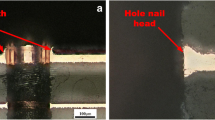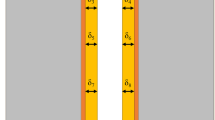Abstract
The laser-assisted seeding (LAS) mechanism has the potential to replace the conventional electroless copper plating in printed circuit board (PCB) manufacture because it combines the steps of drilling and electroless plating into one. The LAS mechanism should be able to plate microvias with high aspect ratio that may not be feasible by conventional electroless plating due to the small via geometry. The conventional electroless plating process generates considerable quantities of chemical waste. In particular, the plating of microvia with high aspect ratio close to 1 is difficult due to the limited accessibility of chemical solution to the via internal wall surface in conventional plating technology. LAS is a promising alternative. The objectives of this paper are to report the deposition mechanism of a thin copper film layer (laser-assisted seeding) on PCB microvias dielectric and to study the thermal reliability of the microvias produced by this mechanism. Results find that the microvias produced by LAS are thermally and electrically as reliable as conventional electroless plating technology.
Similar content being viewed by others
References
Owen M (1997) Laser system and method for plating vias. United States Patent 5,614,114
Raman S, Jeong JH, Kim SJ, Sun B, Park KY (1999) Laser (UV) microvia application in cellular technology. In: IPC Expo 99, 16–18 March, pp 1–7
Murray J (1996) New materuka from old. Printed Circuit Fabric 19:44
Leung ESW (2001) Laser-assisted plating of printed circuit board (PCB) microvias. Thesis. The Hong Kong Polytechnic University
Awad SB (2000) Shop talk: practical information for finishers: ultrasonics in cleaning and electroplating. Plat Surf Finish 6:20–26
Cilfford T (2000) Thermal-cycle tests: help! Circuit Assembl 11:62–70
Low DKY, Li L, Corfe AG (1999) Characteristics of spatter formation under the effects of different process parameters during laser drilling. In: Proceedings of international AMPT’99 symposium on manufacturing processes. Vol 1, pp 457–466
Krebs HU, Bremert O (1993) Pulsed laser deposition of thin metallic alloys. Appl Phys Lett 62:2341–2343
Graves J (2000) Horizontal electroless copper. Printed Circuit Fabric 23:24–28
Castaldi S, Fritz D, Schaeffer R (1999) Limits of copper plating in high aspect ratio microvias. Circuit World 25(2):35–40
Author information
Authors and Affiliations
Corresponding author
Rights and permissions
About this article
Cite this article
Leung, E., Yung, W. & Lee, W. A study of microvias produced by laser-assisted seeding mechanism in blind via hole plating of printed circuit board. AMT 24, 474–484 (2004). https://doi.org/10.1007/s00170-003-1583-4
Received:
Accepted:
Published:
Issue Date:
DOI: https://doi.org/10.1007/s00170-003-1583-4




